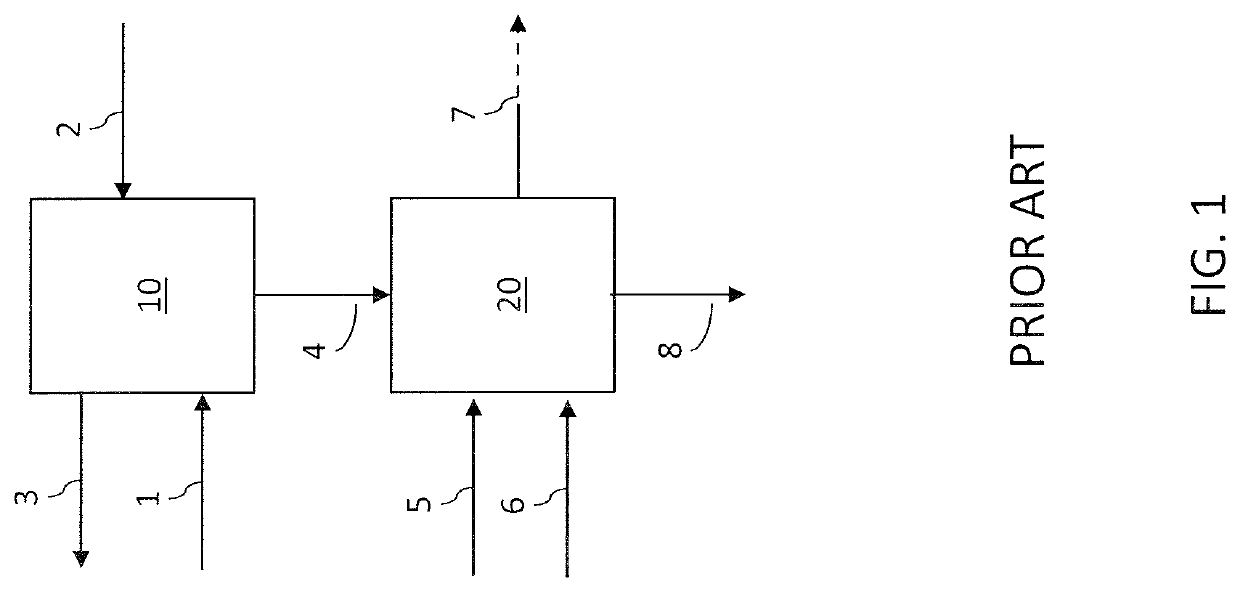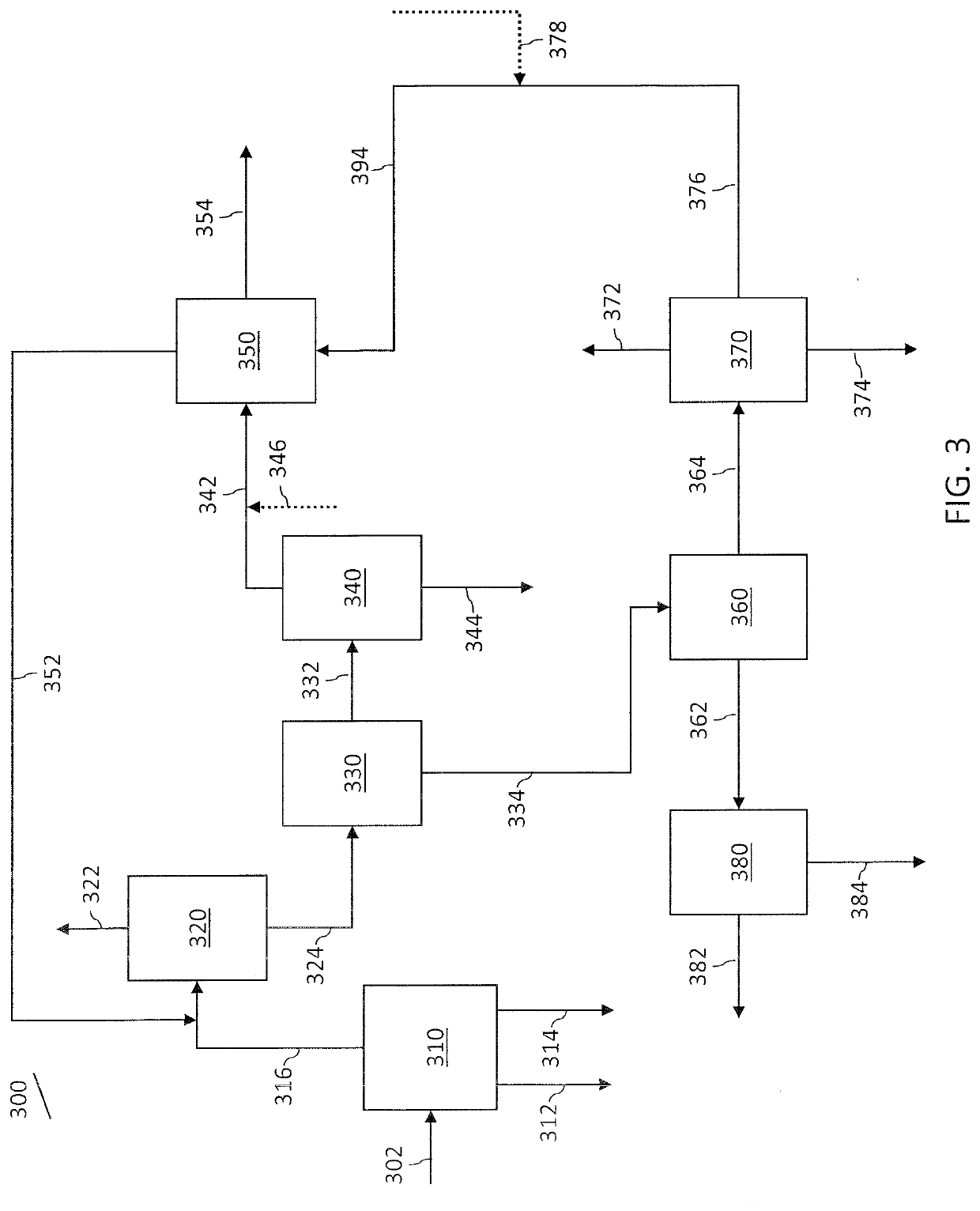Process for fluidized catalytic cracking of disulfide oil to produce ethylene used for metathesis to produce propylene
a technology of disulfide oil and catalytic cracking, which is applied in the direction of hydrocarbon preparation catalysts, hydrocarbon oil treatment products, gaseous mixture working up, etc., can solve the problem of increasing the potential greater volumetric yield of normally liquid hydrocarbon products, reducing the yield of light fraction hydrocarbons, and relatively low feed conversion rate, etc. problem, to achieve the effect of increasing the production of propylen
- Summary
- Abstract
- Description
- Claims
- Application Information
AI Technical Summary
Benefits of technology
Problems solved by technology
Method used
Image
Examples
example 1
[0091]A disulfide oil sample, the properties and composition of which are provided in Table 1, was subjected to a fluidized catalytic cracking process using a Micro Activity Test (MAT) unit. The MAT runs were conducted in a fixed-bed reactor according to ASTM D51549 entitled “Determining Activity and Selectivity of FCC Catalysts by Microactivity Test”. A proprietary FCC catalyst based on USY zeolite was used for the tests. The catalyst comprises a zeolite as an active component and clay as filler, both having microporosity and alumina, and silica as binders having mesoporosity,
[0092]The catalyst was conditioned according to ASTM D4463 entitled “Metals-Free Steam Deactivation of Fresh Fluid Cracking Catalyst”. According to this method, the catalyst used was aged at 810° C. and ambient pressure, i.e., at 1 bar, under a flow of 100% steam for 6 hours. Two tests were conducted at catalyst-to-oil (C / O) ratios of 3.36 and 3.26 and under conventional FCC conditions, i.e., 530° C. Table 2 i...
example 2
[0094]The light olefins produced according to the procedure of Example 1 were then subjected to metathesis according to Embodiment 1 as described above at a temperature of 400° C. and a pressure of 60 bars over a tungsten on silica catalyst.
[0095]Table 3 summarizes the material balance for the integrated FCC and metathesis process. No supplemental ethylene was added in Example 2.
TABLE 3TotalEthyl-Pro-liquidenepyleneStream pro-rich gas C4rich gasNameDSOductsCokeStreamFeedstreamCorre-202214212216294254spondingReference NumberTemperature 530° C.Catalyst / 3.31Oil RatioGas Yields, W %DSO100.00H20.000.00Methane3.643.64Ethane4.254.25Ethylene16.980.05Propane0.080.08Propylene3.200.0043.68Butanes0.123.483.63Butylenes0.7022.940.091,3-Butadiene0.070.07Total Gas29.0426.4355.49Total Gas29.0426.4355.49Total Liquid63.83ProductsCoke7.14Total100.0063.837.1429.0426.4355.49MB Checks100.00100.0155.4755.49
[0096]It has been shown that the fluidized catalytic cracking of a mercaptan oxidation by-product DSO...
example 3
[0097]A disulfide oil and VGO blended sample was subjected to a fluidized catalytic cracking process using a Micro Activity Test (MAT) unit in accordance with the procedure of Example 1 as described above. Three runs were conducted at catalyst-to-oil (C / O) weight ratios of 5.4 and at a DSO / VGO volumetric ratio of 10 / 90, 30 / 70 and 50 / 50, and under conventional FCC conditions, i.e., 530° C. Table 4 indicates the product yields.
TABLE 4Run 1Run 2Run 3DSO / VGO V %10 / 9030 / 7050 / 50Temperature ° C.530530530Catalyst / Oil Ratio5.45.45.4Gas Yields, W %H20.090.070.05Methane0.701.351.99Ethane1.031.762.49Ethylene4.517.2910.06Propane6.154.803.46Propylene8.137.035.94Butanes4.443.472.51Butylenes7.235.784.331,3-Butadiene0.030.050.06Total Gas32.3031.5730.84Total Gas32.3031.5730.84Total liquid66.5065.9065.30productsCoke1.172.513.85Total99.9799.9899.99
[0098]As indicated by the data in Table 4, at 530° C. and varying ratios of DSO to VGO, the fluidized catalytic cracking of the DSO / VGO blended sample yielde...
PUM
| Property | Measurement | Unit |
|---|---|---|
| temperatures | aaaaa | aaaaa |
| temperatures | aaaaa | aaaaa |
| temperatures | aaaaa | aaaaa |
Abstract
Description
Claims
Application Information
 Login to View More
Login to View More - R&D
- Intellectual Property
- Life Sciences
- Materials
- Tech Scout
- Unparalleled Data Quality
- Higher Quality Content
- 60% Fewer Hallucinations
Browse by: Latest US Patents, China's latest patents, Technical Efficacy Thesaurus, Application Domain, Technology Topic, Popular Technical Reports.
© 2025 PatSnap. All rights reserved.Legal|Privacy policy|Modern Slavery Act Transparency Statement|Sitemap|About US| Contact US: help@patsnap.com



